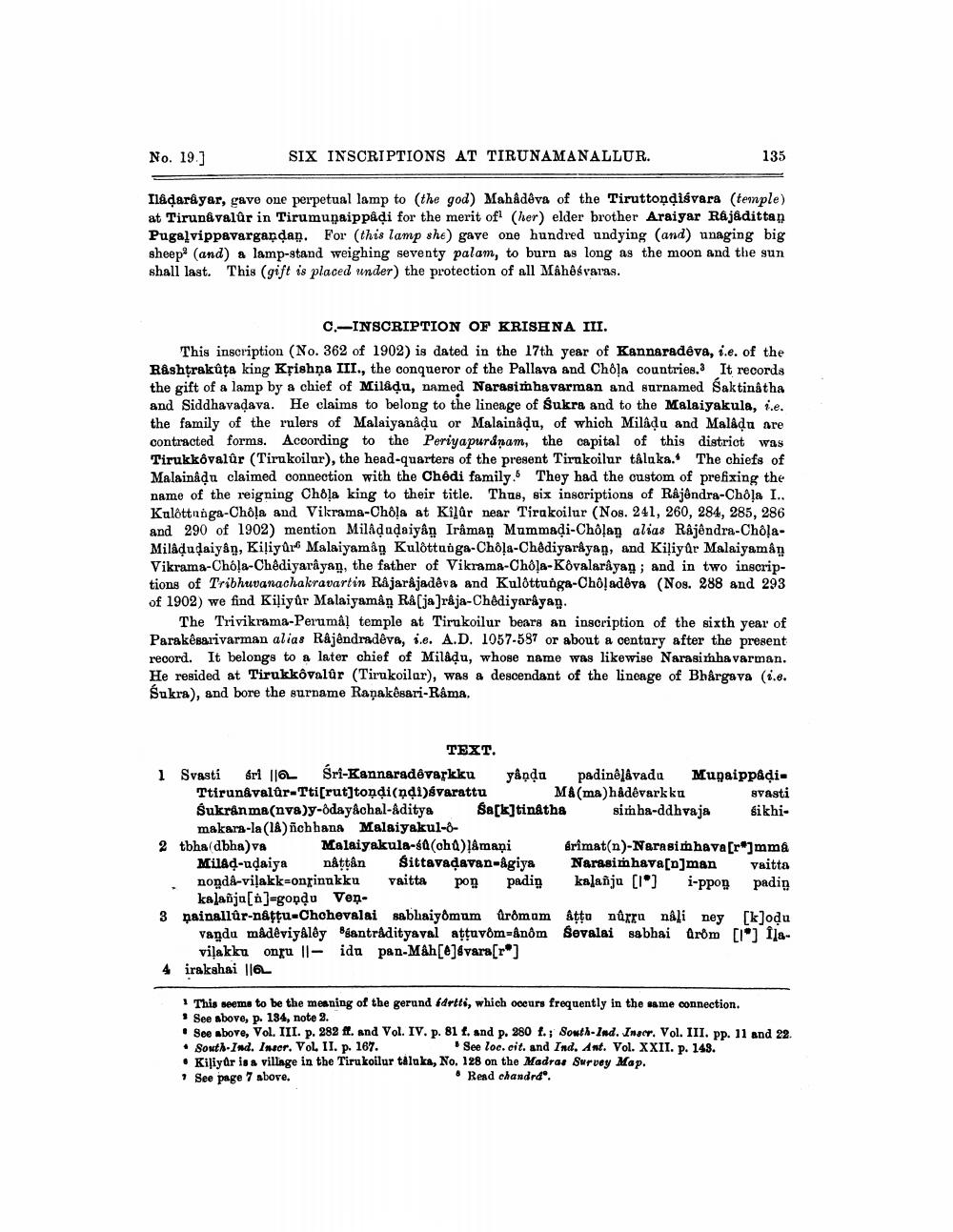________________
No. 19.]
SIX INSCRIPTIONS AT TIRUNAMANALLUR.
135
Ilådarayar, gave one perpetual lamp to the god) Mahadeva of the Tiruttoņdiśvara (temple) at Tiruni valûr in Tirumunaippadi for the merit of (her) elder brother Araiyar Rájådittan Pugalvippavargandan. For this lamp she) gave one hundred undying (and) unaging big sheep (and) a lamp-stand weighing seventy palam, to burn as long as the moon and the sun shall last. This (gift is placed under) the protection of all Mahévaras.
C.--INSCRIPTION OF KRISHNA III. This inscription (No. 362 of 1902) is dated in the 17th year of Kannaradeva, i.e. of the Rashtrakůta king Krishna III., the conqueror of the Pallava and Chola countries. It records the gift of a lamp by a chief of Miladu, named Narasimhavarman and surnamed Saktinatha and Siddhavadava. He claims to belong to the lineage of Sukra and to the Malaiyakula, i.e. the family of the rulers of Malaiyanadu or Malainadu, of which Milâļu and Maladu are contracted forms. According to the Periyapuranam, the capital of this district was Tirukkôvalûr (Tirukoilur), the head-quarters of the present Tirukoilur taluka. The chiefs of Malainâdu claimed connection with the Chôdi family. They had the custom of prefixing the name of the reigning Chola king to their title. Thus, six inscriptions of Rajendra-Chola I.. Kulottnnga-Chola and Vikrama-Chola at Kilûr near Tirukoilur (Nos. 241, 260, 284, 285, 286 and 290 of 1902) mention Miladudaiyan Irama Mummadi-Chola alias Rajendra-CholaMilâdudaiyán, Kisiyur Malaiyaman Kulôttunga-Cha-Chêdiyarayan, and Kiliyar Malaiyaman Vikrama-Chóla-Chêdiyarayan, the father of Vikrama-Cha-Kovalarayan; and in two inscriptions of Tribhuvanachakravartin Rajarajadêva and Kulottunga-Chôļadēva (Nog. 288 and 293 of 1902) we find Kiliyûr Malaiyamån Rå [ja]raja-Chêdiyardyan.
The Trivikrama-Perumal temple at Tirukoilur bears an inscription of the sixth year of Parakesarivarman alias Rajendradêve, i.e. A.D. 1057-587 or about a centary after the present record. It belongs to a later chief of Miladu, whose name was likewise Narasimhavarman. He resided at Tirukkôvalûr (Tirukoilar), was a descendant of the lineage of Bhargava (i.e. Sukra), and bore the surname Raņak@sari-Rama,
TEXT. 1 Svasti eri || Sri-Kannaradevarkku yanda padinelávadu MugaippadiTtirundvalûr-Tti[rut]tondi(ndi)śvarattu
MA(ma)hådêvarkku
svasti Sukranma(nva)y-oday&chal-Aditya Sa[k]tinátha simba-ddhvaja sikhi
makara-la (14) ñcbhana Malaiyakul-82 tbha dbha)va M alaiyakula-80 (oha) l&mapi Arimat(n)-Narasimhava[r]mma
Milad-udaiya nattån Sittavadavan-Ågiya Narasimhava[n]man vaitta noņd-viļakk-onrinukku vaitta pop padin kalañju [] ippon padin
kalañja[i]=goodu Ven. 3 nainallûr-naçţu-Chohevalai sabhaiyomum úrómum áttu nurru nali ney [k]odu
vandu madêviyaley antradityaval attavôm=&nôm Sovalai sabhai Arom [1] 118
viļakku onru ||- idu pan-Mah[@]svara[ro] 4 irakahai ||6L
This seems to be the meaning of the gerund fdrtti, which occurs frequently in the same connection. • See above, p. 184, note 2.
See above, Vol. III. p. 282 ft. and Vol. IV. p. 81 f. and p. 280 f. ; South-Ind. Inger. Vol. III. Pp. 11 and 22. • South-Ind. Inser. VOL II. p. 167.
See loc. cit. and Ind. Ant. Vol. XXII. p. 143. • Kiliyar is a village in the Tirukoilur taluka, No. 128 on the Madras Survey Map. * See page 7 above.
• Read chandrdo




